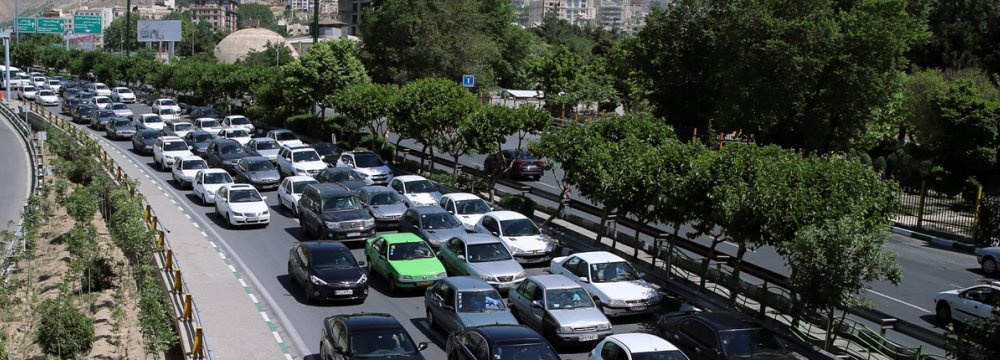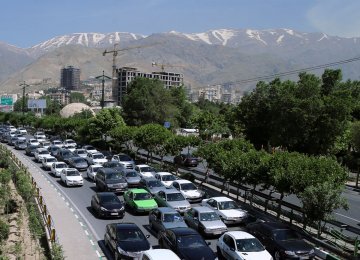Clogged roads and highways in Tehran are just one painful reminder of how urban management has failed in this metropolis of more than 12 million people.
The time, money, energy and nerves wasted every single day in the treacherous traffic in the capital is a huge strain on the environment, economy and quality of life. Overuse and misuse of private cars and lack of efficient and decent public transport are the primary reasons behind the torture of traffic in the ever-expanding Iranian capital, thanks to the verified ineptitude and avarice of the municipality and some city councilors.
In many of the world’s developed countries, private cars are considered a means of luxury transport, and using a car daily doesn’t become necessary at least for the people who live in cities with an acceptable public transport system.
So in these countries when a person wants to use his/her private car, they know that they should “pay the price for making the wrong choice,” that is getting stuck in a traffic jam for hours.
In other words, in well-organized cities in the world expansion of highways or building new roads does not necessarily bring more private cars onto the streets. “Rather by expanding their public transport system, the problem of the likelihood of urban traffic congestion is taken care of,” says Mohammad Mahdi Tondguyan, spokesman for the High Commission for Analyzing Architecture and Urban Plans of the Tehran City Council (TCC).
In Tehran, the worsening traffic congestion has not only turned into a major nuisance but also an unending challenge for the urban authorities whose eligibility, integrity and foresight has long come under a big question mark.
One issue mentioned time and again is that the urban officials often tend to insult the intelligence of the Tehranis. One commuter tells the Tribune how is that during the freezing temperature and when it rains the traffic police that must be on duty at the main crowded junctions and the taxis simply vanish and are nowhere to be seen!? “This has been the dilemma of commuting Tehranis for ages,” says Ali Taheri standing on the corner of an overcrowded street in central Tehran on a wet and cold night this past week.
He makes the point clear: This blame game is political nonsense. What matters is that the urban authorities have simply lost the cherished trust of the residents. They must first worry about this trust deficit.
The capacity of the capital’s public transport system is not enough to meet the needs of this burgeoning city of 12 million people, and therefore “we cannot expect the people not to use their private cars because in the present situation it’s simply not possible (not to do so),” the Tehran councilor says.
The city’s highway network expansion was completed 10 years ahead of the urban development plan. “Tehran Municipality (TM) has not paid attention to this important fact that building more roads can lead to more traffic if this doesn’t keep pace with public transport expansion,” he said.
Echoing the thinking of most experts and residents, the Tehran commuter tells the Tribune, “This city long ran out of space for more cars and the people’s patience has finally run out.”
Daily Influx
The daily influx of people, mainly commuters, brings the ‘daylight’ population of Tehran up to more than 15 million, more than a fifth of the country’s population of 80 million.
It is estimated that more than four million vehicles ply Tehran roads and the municipality estimates that some 19 million daily trips are made in the capital city. According to published reports, “1,000 plus new cars enter the polluted city every day.”
According to the Global Report on Human Settlements 2013, 28% of the trips in Tehran are made by private cars (which are responsible for 88% of local air pollution annually), 22% by bus, 23% by shared taxi, 10% by metro and 10% by minibus.
“The problem of traffic congestion is not due to the construction of Niyayesh Tunnel (opened in February 2013) or Sadr Two-Level Highway (December 2013); the main issue is the unwise prioritization of urban projects,” said Tondguyan.
“When we face delays in the metro expansion project, development of highways is not rational,” he maintained. The Tehran Municipality (TM) should restrict its public transport budget on expanding highways for private cars.”
It needs mention that some of the highway expansion projects were implemented during the tenure of the previous administration.
Metro Expansion Project
The last metro station that opened in Tehran was Hussein Abad station located on Tehran Metro Line 3 (between Heravi and Nobonyad stations in district four). It was inaugurated on December 13.
In all, 116 subway stations have been constructed so far. Tehran Metro carries more than 3 million passengers a day. At present, the subway system comprises five operational lines (1, 2, 3, 4 and 5 – line 3 is not fully completed). Lines 6 and 7 are currently under construction.
Earlier, Habil Darvishi, the managing director of Tehran Urban and Suburban Railway Operation Company told IRNA that, “We have plans to complete line 6 (31 km with 29 stations) to connect southeast Tehran to northwest, and line 7 (27 km with 23 stations) by the end of the next Iranian year in March 2017.”
However, deputy mayor Maziar Hosseini said recently that while the excavation work has been completed, only 10 km of the tracks have been laid so far for Line 7, which means less than 50% of the project has been completed The excavation work on Line 6 still remains incomplete.







Add new comment
Read our comment policy before posting your viewpoints